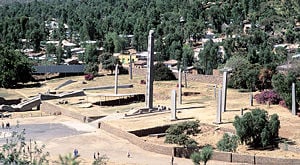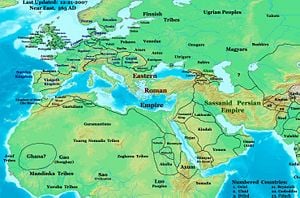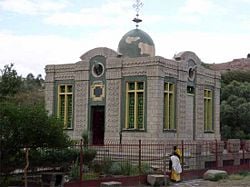Axum
- For other uses, see Axum (disambiguation).
| Aksum* | |
|---|---|
| UNESCO World Heritage Site | |

| |
| State Party | |
| Type | Cultural |
| Criteria | i, iv |
| Reference | 15 |
| Region** | Africa |
| Inscription history | |
| Inscription | 1980 (4th Session) |
| * Name as inscribed on World Heritage List. ** Region as classified by UNESCO. | |
Axum, or Aksum, is a city in northern Ethiopia named after the Kingdom of Aksum, a naval and trading power that ruled from the region ca. 400 B.C.E. into the 10th century. The kingdom was occasionally referred to in medieval writings as "Ethiopia".
Located in the Mehakelegnaw Zone of the Tigray Region near the base of the Adwa mountains, the city has an elevation of 2,130 meters. It was the centre of the (eventual) Christian marine trading power the Aksumite Kingdom, which predated the earliest mentions in Roman era writings (around the time of the birth of Jesus) in good correlation to the expansion of Rome into northern Africa, and later when it developed into the Christian kingdom, was a quasi-ally of Byzantium against the day's Persian Empire. The historical record is unclear, primary sources being in the main limited to ancient church records.
It is believed it began a long slow decline after the 7th century due partly to Islamic groups contesting trade routes. Eventually Aksum was cut off from its principal markets in Alexandria, Byzantium and Southern Europe and its trade share was captured by Arab traders of the era. The Kingdom of Aksum also quarreled with Islamic groups over religion. Eventually the people of Aksum were forced south and their civilization declined. As the kingdom's power declined so did the influence of the city, which is believed to have lost population in the decline similar to Rome and other cities thrust away from the flow of world events. The last known (nominal) king to reign was crowned ca. 10th century, but the kingdom's influence and power ended long before that.
Its decline in population and trade then contributed to the shift of the power centre of the Ethiopian Empire so that it moved further inland and bequeathed its alternative place name (Ethiopia) to the region, and eventually, the modern state.[1]
Based on figures from the Central Statistical Agency in 2005, Axum has an estimated total population of 47,320 of whom 20,774 were males and 21,898 were females.[2] Seventy-five percent of the people in the city are members of the Ethiopian Orthodox Church. The remainder of the population is Sunni Muslim and P'ent'ay (Protestant and other non-Orthodox Christians).
Aksum is served by an airport (ICAO code HAAX, IATA AXU).
Due to their historical value, in 1980 UNESCO added Aksum's archaeological sites to its list of World Heritage Sites.
The Aksumite kingdom and the Ethiopian Church
The kingdom of Aksum had its own written language called Ge'ez, and also developed a distinctive architecture exemplified by giant obelisks, the oldest of which (though much smaller) date from 5,000-2,000 B.C.E.[3] This kingdom was at its height under king Ezana, baptized as Abreha, in the 300s (which was also when it officially embraced Christianity).[4]
The Ethiopian Orthodox Church claims that the Church of Our Lady Mary of Zion in Aksum houses the Biblical Ark of the Covenant in which lies the Tablets of Law upon which the Ten Commandments are inscribed.[5] This same church was the site Ethiopian emperors were crowned for centuries until the reign of Fasilides, then again beginning with Yohannes IV until the end of the empire. Axum is considered to be the holiest city in Ethiopia and is an important destination of pilgrimages.[5] Significant religious festivals are the T'imk'et Festival (known as the Epiphany in western Christianity) on 7 January and the Festival of Maryam Zion in late November.
In 1937, a 24-metre tall, 1700-year-old obelisk standing in Axum was cut into three parts by Italian soldiers and shipped to Rome to be re-erected. The obelisk is widely regarded as one of the finest examples of engineering from the height of the Axumite empire. Despite a 1947 United Nations agreement that the obelisk would be shipped back, Italy balked, resulting in a long-standing diplomatic dispute with the Ethiopian government, which views the obelisk as a symbol of national identity. In April 2005, Italy finally returned the obelisk pieces to Axum amidst much official and public rejoicing, Italy also covered the $4 million costs of the transfer. UNESCO has assumed responsibility for the re-installation of this stele in Axum, and as of the end of July 2008 the obelisk has been reinstalled (see panographic photos in external links below). Rededication of the obelisk took place on September 4, 2008 in Paris, France with Ethiopian Prime Minister Meles Zenawi dedicating the obelisk to Italian President Giorgio Napolitano for his kind efforts in returning the obelisk.
Axum and Islam
Although Axumite Muslims have attempted to build a mosque in this most holy of Ethiopian towns, Orthodox residents, and the emperors of the past have replied that they must be allowed to build an Ethiopian Orthodox church in Mecca if the Muslims are to be allowed to build a mosque in Axum.[citation needed]
The connection of Axum with Islam is very old.[citation needed] According to ibn Hisham,[citation needed] when Muhammad faced oppression from the Quraish clan, he sent a small group that included his daughter Ruqayya and her husband Uthman ibn Affan, whom Ashama ibn Abjar, the king of Axum, gave refuge to, and protection to, and refused the requests of the Quraish clan to send these refugees back to Arabia.[citation needed] These refugees did not return until the sixth year of the Hijra (628), and even then many remained in Ethiopia, eventually settling at Negash in eastern Tigray.[citation needed]
There are different traditions concerning the effect these early Muslims had on the ruler of Axum. The Muslim tradition is that the ruler of Axum was so impressed by these refugees that he became a secret convert.[6] On the other hand, arabic historians & Ethiopian tradition states that some of the Muslim refugees who lived in Ethiopia during this time converted to Orthodox Christianity. Worth mentioning is a second Ethiopian tradition that, on the death of Ashama ibn Abjar, Muhammed is reported to have prayed for the king's soul, and told his followers, "Leave the Abyssinians in peace, as long as they do not take the offensive.[7]
Sites of interest
The major Aksumite monuments in the town are stelae; the largest number lie in the Northern Stelae Park, ranging up to the 33-metre (33 M high 3.84 M wide 2.35 M deep 520 tonnes) Great Stele, believed to have fallen and broken during construction. The tallest standing is the 24-metre (20.6 M high 2.65 M wide 1.18 M deep 160 tonnes) King Ezana's Stele. Another stele (24.6 M high 2.32 M wide 1.36 M deep 170 tonnes) looted by the Italian army was returned to Ethiopia in 2005 and reinstalled July 31 2008 [8]. This stele was broken into 3 pieces before being looted. Three more stele measure 18.2 M high 1.56 M wide 0.76 M deep 56 tonnes, 15.8 M high 2.35 M wide 1 M deep 75 tonnes, 15.3 M high 1.47 M wide 0.78 M deep 43 tonnes [9] The stelae are believed to mark graves and would have had cast metal discs affixed to their sides, which are also carved with architectural designs. The Gudit Stelae to the west of town, unlike the northern area, are interspersed with mostly fourth-century tombs.
Other features of the town include St Mary of Zion church, built in 1665 and said to contain the Ark of the Covenant (a prominent twentieth-century church of the same name neighbours it), archaeological and ethnographic museums, the Ezana Stone written in Sabaean, Ge'ez and Ancient Greek in a similar manner to the Rosetta Stone, King Bazen's Tomb (a megalith considered to be one of the earliest structures), the so-called Queen of Sheba's Bath (actually a reservoir), the fourth-century Ta'akha Maryam and sixth-century Dungur palaces, the monasteries of Abba Pentalewon and Abba Liqanos and the Lioness of Gobedra rock art.
Local legend claims the Queen of Sheba lived in the town.
Sister cities
See also
- List of megalithic sites
ReferencesISBN links support NWE through referral fees
- ↑ G. Mokhtar, UNESCO General History of Africa, Vol. II, Abridged Edition (Berkeley: University of California Press, 1990), pp. 215-35. ISBN 0-85255-092-8
- ↑ CSA 2005 National Statistics, Table B.4
- ↑ Herausgegeben von Uhlig, Siegbert, Encyclopaedia Aethiopica: D-Ha (Wiesbaden: Harrassowitz Verlag, 2005), p. 871.
- ↑ J.D. Fage, A History of Africa (London: Routledge, 2001). pp. 53-54. ISBN 0-415-25248-2
- ↑ 5.0 5.1 Hodd, Mike, Footprint East Africa Handbook (New York: Footprint Travel Guides, 2002), p. 859. ISBN 1-900949-65-2
- ↑ Ibn Ishaq, The Life of Muhammad (Oxford, 1955), 657-58.
- ↑ Paul B. Henze, Layers of Time: A History of Ethiopia (New York: Palgrave, 2000), pp. 42f
- ↑ "Mission accomplished: Aksum Obelisk successfully reinstalled" (August 1, 2008)
- ↑ Scarre, Chris Seventy Wonders of the Ancient World 1999
Further reading
- Francis Anfray. Les anciens ethiopiens. Paris: Armand Colin, 1991.
- Yuri M. Kobishchanov. Axum (Joseph W. Michels, editor; Lorraine T. Kapitanoff, translator). University Park, Pennsylvania: University of Pennsylvania, 1979. ISBN 0-271-00531-9
- David W. Phillipson. Ancient Ethiopia. Aksum: Its antecedents and successors. London: The British Brisith Museum, 1998.
- David W. Phillipson. Archaeology at Aksum, Ethiopia, 1993-97. London: Brisith Institute in Eastern Africa, 2000.
- Stuart Munro-Hay. Aksum: An African Civilization of Late Antiquity. Edinburgh: University Press. 1991. ISBN 0-7486-0106-6 online edition
- Stuart Munro-Hay. Excavations at Aksum: An account of research at the ancient Ethiopian capital directed in 1972-74 by the late Dr Nevill Chittick London: British Institute in Eastern Africa, 1989 ISBN 0-500-97008-4
- Sergew Hable Sellassie. Ancient and Medieval Ethiopian History to 1270 Addis Ababa: United Printers, 1972.
- African Zion, the Sacred Art of Ethiopia. New Haven: Yale University Press, 1993.
External links
- Ethiopian Treasures — Queen of Sheba, Aksumite Kingdom — Aksum
- Kingdom of Aksum article from "About Archaeology"
- UNESCO – World Heritage Sites — Aksum
- The Metropolitam Museum of Art — "Foundations of Aksumite Civilization and Its Christian Legacy (1st–7th century)"
- On Axum
- More on Axum
- Axum from Catholic Encyclopedia
- Final obelisk section in Ethiopia, BBC, 25 April 2005
- Axum Heritage Site on Aluka digital library
- Aksum World Heritage Site in panographies - 360 degree interactive imaging
Credits
New World Encyclopedia writers and editors rewrote and completed the Wikipedia article in accordance with New World Encyclopedia standards. This article abides by terms of the Creative Commons CC-by-sa 3.0 License (CC-by-sa), which may be used and disseminated with proper attribution. Credit is due under the terms of this license that can reference both the New World Encyclopedia contributors and the selfless volunteer contributors of the Wikimedia Foundation. To cite this article click here for a list of acceptable citing formats.The history of earlier contributions by wikipedians is accessible to researchers here:
The history of this article since it was imported to New World Encyclopedia:
Note: Some restrictions may apply to use of individual images which are separately licensed.

